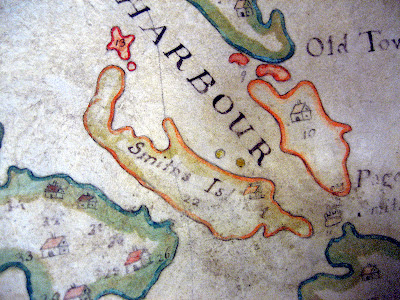Welcome to the Smiths Island Archaeology Project!
 |
| 1899 Savage Map |
Welcome to Michael Jarvis's Smiths Island Archaeology Project Website. Most people today know Bermuda for its pink sand beaches, honeymoon suites, offshore companies, and global business centers, but the island has an even richer history: It is the oldest colony in the British Empire and celebrated its 400th anniversary in 2012. At only 22 square miles, the island is packed with four centuries of dynamic history – a wonderful laboratory for studying the blending of European, African, and American cultures that characterize the Atlantic World. St. George’s (where we will be based) was founded in 1612 and boasts dozens of houses built in the 17th and 18thcenturies. The sites we hope to find on Smiths Island are even older, dating to 1610. Historical archaeology on land in Bermuda is a mere two decades old; most previous excavations have focused on fortifications, churches, and eighteenth-century domestic sites, but our investigations seek to shed light on the lives of Bermuda’s earliest English, African, and Native American settlers. We are fortunate that prudent preservation efforts by the Bermuda National Trust and National Parks have saved Smiths Island from the rapid pace of development that has recently occurred in much of Bermuda.
This project began in June 2010 with focused documentary research in the Bermuda Archives to reveal Smiths Island's succession of residents and an intensive survey of the Parks portion of Smiths Island. The small volunteer team included Rick Spurling, U of R graduate student Alexandra Mairs, and my 11-year-old daughter Charlotte. We discovered 14 sites in eight areas in the western half of the Park:
The most promising site discovered was a very primitive house foundation that appears to be related to a timber-frame building situated in the approximate location of a house marked on Richard Norwood's 1663 survey:
After mapping the site, a small test unit revealed 17th and 18th-century artifacts related to the period after the house had been abandoned.
This summer (2012), my University of Rochester archaeological field school will continue to excavate this site with the goal of defining its dimensions, determining the construction techniques employed, and gathering data about its residents' trade and consumption patterns. We will also continue to look for the house site of the three sailors who occupied Smiths Island in 1611 and 1612 - arguably the First Bermudians - and evidence of the early, aborted construction of Bermuda's first town in July 1612.
Smiths Island has been inhabited since 1610, when 3 sailors left behind after the Sea Venture's shipwrecked castaways left Bermuda for Virginia. They built a one-acre farm, a shallop and other boats, and grew the first commercially viable tobacco in English America. When Bermuda's first deliberately sent settlers arrived in July 1612, they began building Bermuda's first town on Smiths Island but soon shifted its location across the harbour to St. George's. A map of Bermuda circa 1616 shows two houses on Smiths Island. The Asser, Sharpe, and Pitcher families and their slaves farmed throughout the 17th and 18th centuries. From the 1660s until the 1920s, a whalehouse and processing station operated on Smiths Island's north shore. A fine Georgian mansion was built by Dr. George Forbes as a country house and family retreat in 1786 to the west of the whalehouse. A smallpox quarantine cabin was apparently built around the same time to house infected passengers arriving by ship in Bermuda. The island was farmed throughout the 19th century and into the early 1980s.Today, the eastern third of Smiths Island is a national park and the western third is a reserve belonging to the Bermuda National Trust. Because Smiths Island. It offers an exceptionally well preserved assemblage of sites to research Bermuda's early agricultural and maritime past, with especial promise in revealing how Bermuda's first settlers adapted to life in a new colony, the island's now entirely lost early timber-frame architecture, and aspects of enslaved Bermudians' activities.





Comments
Post a Comment